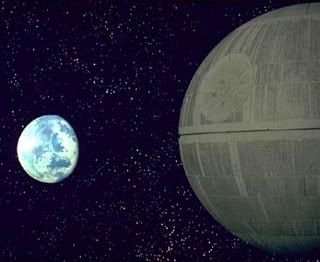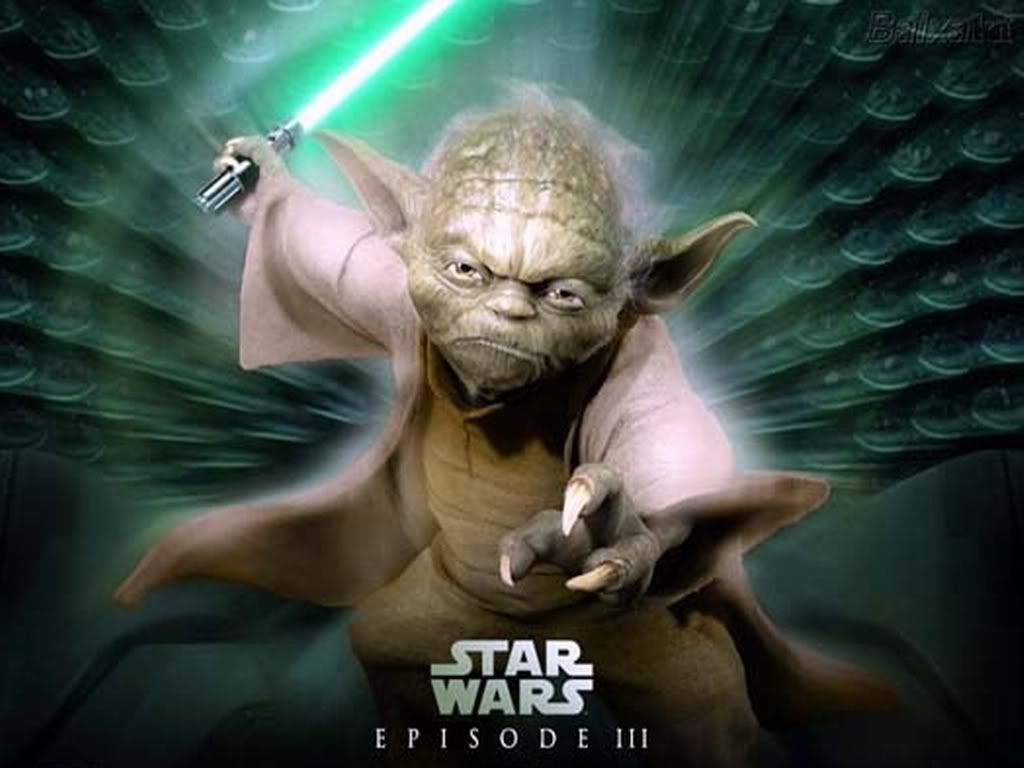Post by Rose on Apr 19, 2007 0:28:06 GMT -5
Death Star


Basic Information -
Height: 120 Kilometers in Diameter
Weapon: Superlaser
Affiliation: Empire
Associations: Emperor's Throne Room; Imperial Gunners; Imperial Navy Troopers; Jerjerrod, Moff; Motti, Admiral; Tagge, General; Tarkin, Grand Moff
The Death Star was the code name of an unspeakably powerful and horrific weapon developed by the Empire. The immense space station carried a weapon capable of destroying entire planets. The Death Star was to be an instrument of terror, meant to cow treasonous worlds with the threat of annihilation. While the massive station is evidence of the evil that was the Galactic Empire, it was also proof of the New Order's greatest weakness -- the belief that technology and terror were superior to the will of oppressed beings fighting for freedom. The Death Star was a battle station the size of a small moon. It had a formidable array of turbolasers and tractor beam projectors, giving it the firepower of greater than half the Imperial starfleet. Within its cavernous interior were legions of Imperial troops and fightercraft, as well as all manner of detention blocks and interrogation cells. The Death Star was spherical, and dark gray in color. Located on the Death Star's northern hemisphere was a concave disk housing the station's main laser weapon.
The technical schematics for the Death Star were developed by the cutting edge technologists of the Confederacy of Independent Systems during the Clone Wars. With the defeat of the Separatists and the Republic's transformation into Empire, the Death Star project fell under the command of Grand Moff Tarkin, one the Empire's preeminent governors. The Death Star was developed in secret, through many difficulties over a span of almost 20 years. Rebel Alliance spies were nonetheless able to learn of the weapon's existence, and stole vital technical schematics from guarded Imperial vaults. These desperate spies transmitted this data to Rebel leader Princess Leia Organa, who stored the plans in R2-D2's memory systems. In a brutal display of the Death Star's power, Grand Moff Tarkin targeted its prime weapon at the peaceful world of Alderaan. Leia Organa, an Imperial captive at the time, was forced to watch as the searing laser blast split apart her beloved world, turning the planet and its populace into orbital ash and debris.
Using the stolen technical data, Alliance tacticians were able to pinpoint a crucial flaw in the Death Star's design. A small ray-shielded thermal exhaust port led directly from the surface of the station into the heart of its colossal reactor. If the port could be breached by proton torpedoes, then the resulting chain reaction would destroy the station. The Rebel Alliance boldly launched its available starfighter forces against the station. The Imperials were so confident in the Death Star's might that they never considered the Rebel fighters a viable threat. After all, the station was designed to withstand a full frontal assault from large capital ships. At first, the Empire didn't even launch TIE fighters to counter the attack. With the aid of Han Solo, the spirit of Obi-Wan Kenobi, and the power of the Force, Luke Skywalker was able to successfully hit the small target, and triggered the Death Star's demise.
Over three years later, the threat of the Death Star returned, as the Alliance discovered a second, larger Death Star under construction over the remote forest moon of Endor. The Death Star project fit well with the Doctrine of Fear proposal that Grand Moff Tarkin made to Emperor Palpatine. Rather than expend the incredible amounts of resources necessary to subjugate all the worlds of the Empire, the New Order would instead make visible a single show of force that could be used to quell any treasonous activity. With Palpatine's approval, Tarkin was appointed to make this vision a reality. Though the plans developed by the Confederacy during the Clone Wars were remarkably brilliant and advanced, the practical application of so many new technologies at such an unprecedented scale required years of research and development. Many began to doubt if the Death Star would ever become a reality as the years slogged on. Repeated, if ill-fated, sabotage attempts did little to assuage the fears of the skeptical.
When the superlaser project hit a critical development roadblock, an enclave of top scientists were recruited or forcibly assigned to the Death Star development project. Tarkin maintained a top-secret laboratory code-named Maw Installation in the heart of one of the most inhospitable regions of the galaxy. There, scientists such as Qwi Xux, Tol Sivron and Bevel Lemelisk developed design concepts and engineering breakthroughs that would make the Death Star possible. Once a functional test model proved that the technical refinements to the Death Star would work, Bevel Lemelisk took the plans from Maw Installation to the remote Outer Rim world of Despayre. There, prison labor mined the world for the necessary materials needed to finalize this weapon of terror. After long years of toil, during which many slaves died, the Death Star finally was completed. To mark the occasion, and to test its superlaser, Despayre became the first world targeted by the gargantuan weapon. The planet that was the Death Star's cradle was utterly obliterated.
Even before the Death Star became fully operational, its detention blocks began to fill with detainees. Political troublemakers, Rebel insurgents, dangerous pirate forces and other enemies of the Empire were made to quietly "disappear" from public view within the enormous prisons of the still-classified battle station. The stormtroopers of the 501st Legion were among those assigned to protect the Death Star's interior. They were forced to put down a prison break that had somehow occurred within the station. Shortly after this embarrassing debacle, the 501st were reassigned and moved off the station. The Death Star was 120 kilometers in diameter. Much of its interior space was devoted to systems required to maintain its massive superlaser and power plant. At the heart of the Death Star is a gigantic hypermatter reactor. Within this chamber burned a fusion reaction of prodigious proportions, fed by stellar fuel bottles lining its periphery.
Facilitating the Death Star's realspace propulsion were a network of powerful ion engines that transformed reactor power into needed thrust. In order for the Death Star to be a viable threat, it needed to be mobile. Using linked banks of 123 hyperdrive field generators tied into a single navigational matrix, the Death Star could travel across the galaxy at superluminal velocities. The incredible energies harnessed by the station combined with its great mass gave the Death Star magnetic and artificial gravitational fields equal to those found on orbital bodies many times greater in size. The Death Star's superlaser derived power directly from the hypermatter reactor. Its faceted amplification crystal combined the destructive power of eight separate tributary beams into one single blast with the intensity of a stellar core. Though the energy output of this blast could be scaled to fire at smaller targets such as capital ships, the two instances in which the superlaser was fired were at full power at planetary bodies.
The Death Star's interior follows two orientations. Those areas closest to the surface are built with concentric decks with gravity oriented towards the Death Star's core. Past this shell of surface "sprawls," the Death Star's interior had stacked decks with gravity pointing toward the station's southern pole. Splitting the station into two equal hemispheres was a huge equatorial trench 376 kilometers in length. This area of the station housed most of the major landing bays, drive thrusters, sensor arrays and tractor beam systems. Halfway between the equator and each pole were two supplementary trenches. The Death Star was divided into 24 zones, 12 per hemisphere, each controlled by a "bridge." To further organize the immense amount of activity aboard, there were specific "sectors" denoting function. These included the General, Command, Military, Security, Service and Technical sectors.
Since service on the Death Star was a long-term affair, the station maintained a number of civilian amenities to make the time aboard a deep space station more comfortable. Parks, shopping centers and recreation areas could be found in the general sectors of the station. The Death Star operation was commanded by a triumvirate made up of Governor Tarkin, Admiral Motti, and General Tagge. Although separate from the command structure, Darth Vader was an influential presence aboard the station as the personal emissary of the Emperor. These high-ranking officials would make command decisions from the overbridge, the nerve center of the Death Star. This command station was situated just above the top edge of the superlaser dish. Scattered across the Death Star's surface were thousands of weapons emplacements: a total of 10,000 turbolaser batteries, 2,500 laser cannons, 2,500 ion cannons and 768 tractor beam projectors.
The station carried a crew of 265,675, plus 52,276 gunners, 607,360 troops, 25,984 stormtroopers, 42,782 ship support staff, and 167,216 pilots and support crew. The station also carried 7,200 starfighters, four strike cruisers, 3,600 assault shuttles, 1,400 AT-ATs, 1,400 AT-STs, 1,860 drop ships, and more. A Rebel mercenary, Kyle Katarn, stole the Death Star plans from an Imperial data vault on Danuta. He transmitted these plans to Rebel spies in the Toprawa system. These plans were combined with similar technical data secured by Keyan Farlander to construct a full schematic of the Death Star. It was through the efforts of these Rebel heroes, and others, that a weakness was found in the Emperor's most prized weapon. The Death Star was but the first in a long series of superweapons developed by the Tarkin Doctrine. Following its destruction, other weapons followed, including the Tarkin, the second Death Star, the Galaxy Gun, the Sun Crusher and the World Devastators.
